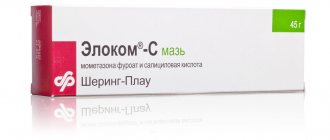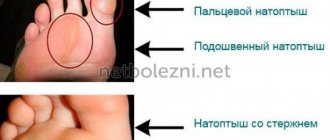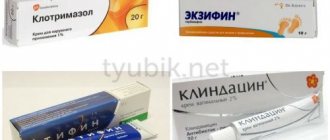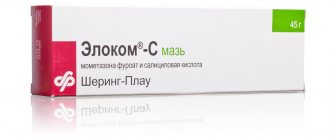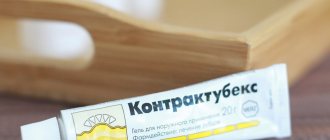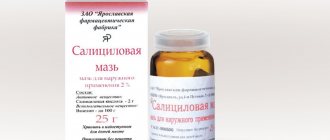Pharmacodynamics
Tacrolimus belongs to the group of calcineurin inhibitors. It binds to a specific cytoplasmic protein immunophilin (FKBP12), which is a cytosolic receptor for calcineurin (FK506). As a result, a complex is formed that includes tacrolimus, FKBP12, calcium, calmodulin and calcineurin, which leads to inhibition of the phosphatase activity of calcineurin. This makes it impossible to dephosphorylate and translocate the nuclear factor of activated T cells (NFAT), which is necessary to initiate transcription of genes encoding the production of cytokines key to the T-cell immune response (IL-2 and interferon-gamma). In addition, tacrolimus inhibits the transcription of genes encoding the production of cytokines such as IL-3, IL-4, IL-5, granulocyte-macrophage colony-stimulating factor (GMCSF) and TNF-α, which are involved in the initial stages of T-lymphocyte activation. In addition, under the influence of tacrolimus, the release of inflammatory mediators from mast cells, basophils and eosinophils is inhibited, as well as the expression of FcεRI (high-affinity surface receptor for IgE) on Langerhans cells is reduced, which leads to a decrease in their activity and antigen presentation to T lymphocytes.
Tacrolimus ointment does not affect collagen synthesis, etc. does not cause skin atrophy.
Pharmacokinetics
Absorption.
Absorption of tacrolimus into the systemic circulation when applied topically is minimal. In the majority of patients with atopic dermatitis (adults and children), both with a single application and with repeated use of 0.03 and 0.1% tacrolimus ointment, its plasma concentration was <1 ng/ml. Systemic absorption depends on the area of the lesion and decreases as the clinical manifestations of atopic dermatitis disappear. Cumulation of the drug with long-term use (up to 1 year) in children and adults was not observed.
Distribution in the body.
Due to the low systemic absorption of tacrolimus ointment, high plasma protein binding (>98.8%) is considered clinically insignificant.
Metabolism.
Tacrolimus is not metabolized in the skin. Once in the systemic circulation, tacrolimus is extensively metabolized in the liver via CYP3A4.
Excretion.
With repeated local use of tacrolimus ointment, T1/2 is 75 hours in adults and 65 hours in children.
Reviews about Protopika
Reviews about Protopic ointment can be found in a variety of ways. As a rule, those who have already tried this remedy on themselves report that it helped them. However, very often there are reports that when using the cream, severe itching, pain, redness and other undesirable manifestations on the skin appeared.
In addition, on forums people often ask whether this drug is hormonal or not. Patients with atopic dermatitis are afraid of side effects that may occur with prolonged use of this drug. Experts rush to reassure them - the medicine is not hormonal. However, like corticosteroid hormones , it can negatively affect immunity .
Reviews of Protopic report that the product helps in an average week. There are, however, also negative opinions. Such reviews about Protopic are left by those for whom it was not effective. These people suffered from adverse reactions on the skin, but did not notice the effect of the ointment. Also, some patients express concern that this drug may cause cancer.
Contraindications
hypersensitivity to tacrolimus, excipients, macrolides;
patients with genetic defects of the epidermal barrier, such as Netherton's syndrome, as well as generalized erythroderma due to the risk of a progressive increase in systemic absorption of tacrolimus;
pregnancy;
breast-feeding;
children and adolescents under 16 years of age (at a dosage of 0.1%), children under 2 years of age (at a dosage of 0.03%).
Carefully:
patients with decompensated liver failure (despite the fact that Protopic® is largely metabolized in the liver, and its concentration in the blood when applied externally is very low); patients with extensive skin lesions, especially when used for long courses; childhood.
Protopica price, where to buy
The cream can be found in many, including foreign pharmacies. The price of Protopik 0.1% is about 1,600 rubles. And you can buy 0.03% ointment for an average of 1,500 rubles. This price of Protopic is too high for many. Therefore, patients are often interested in analogues of this drug. However, the cost of most of them is as high as the price of Protopic ointment.
- Online pharmacies in UkraineUkraine
Pharmacy24
- Protopic 0.03% 10 g ointment
384 UAH. order - Protopic 0.1% 10 g ointment
384 UAH order
Side effects
The most common adverse reactions are symptoms of skin irritation (burning and itching sensation, redness, pain, paresthesia and rash) at the site of application. As a rule, they are moderate and disappear within the first week after the start of treatment.
Alcohol intolerance (facial redness or symptoms of skin irritation after drinking alcohol) is common.
Patients using Protopic® ointment have an increased risk of developing folliculitis, acne and herpetic infections.
By frequency of occurrence, adverse reactions are divided as follows: very often - >1/10; often - >1/100, <1/10 and rarely - >1/1000, <1/100. Within each group, adverse reactions are presented in descending order of importance.
General disorders and local reactions:
very often - burning and itching at the site of application; often - a feeling of warmth, redness, pain, irritation, rash in the area of application.
Infections:
often - herpetic infection (herpes simplex of the face and lips, Kaposi's varicelliform rash).
Skin and subcutaneous tissue:
often - folliculitis, itching; infrequently - acne.
Nervous system:
often - paresthesia, hyperesthesia.
Metabolism and nutritional habits:
often - alcohol intolerance (facial hyperemia or symptoms of skin irritation after drinking alcohol).
During the entire period of observation of the drug, isolated cases of rosacea and malignancy (skin and other types of lymphomas, skin cancer) were recorded.
Interaction
Tacrolimus is not metabolized in the skin, eliminating the risk of drug interactions in the skin that could affect its metabolism. Since the systemic absorption of tacrolimus when used in ointment form is minimal, interaction with CYP3A4 inhibitors (including erythromycin, itraconazole, ketoconazole, diltiazem) when used simultaneously with Protopic ointment is unlikely, but cannot be completely excluded in patients with large areas lesions and/or erythroderma.
The effect of Protopic® ointment on the effectiveness of vaccination has not been studied. However, due to the potential risk of reduced effectiveness, vaccination must be carried out before starting to use the ointment or 14 days after the last use of Protopic® ointment. If a live attenuated vaccine is used, this period should be extended to 28 days, otherwise alternative vaccines should be considered.
The possibility of combined use of Protopic® ointment with other external drugs, systemic corticosteroids and immunosuppressants has not been studied.
Protopic Ointment, tube, 10 g, 0.03%, for external use
Side effect
From the cardiovascular system: very often - myocardial ischemia, tachycardia, arterial hypertension, bleeding, thromboembolic and ischemic complications, impaired peripheral circulation, arterial hypotension; uncommon - ventricular arrhythmias and cardiac arrest, heart failure, cardiomyopathies, ventricular hypertrophy, supraventricular arrhythmias, palpitations, abnormal ECG readings, cardiac arrhythmias, heart rate and pulse, heart attack, deep vein thrombosis of the extremities, shock; rarely - pericardial effusion; very rarely - echocardiogram abnormalities. From the hematopoietic system: often - anemia, leukopenia, thrombocytopenia, leukocytosis; uncommon - pancytopenia, neutropenia; rarely - thrombotic thrombocytopenic purpura. From the blood coagulation system: infrequently - coagulopathies, deviations in coagulogram parameters, rarely - hypoprothrombinemia. From the side of the central nervous system: very often - tremor, headache, insomnia; common - epileptoid seizures, disturbances of consciousness, paresthesia and dysesthesia, peripheral neuropathies, dizziness, writing impairment, anxiety, confusion and disorientation, depression, depressed mood, emotional disorders, nightmares, hallucinations, mental disorders; infrequently - coma, hemorrhages in the central nervous system and cerebrovascular accidents, paralysis and paresis, encephalopathy, speech and articulation disorders, amnesia, psychotic disorders; rarely - increased muscle tone; very rarely - myasthenia. From the organ of vision: often - blurred vision, photophobia, eye diseases; infrequently - cataracts; rarely - blindness. From the organ of hearing: often - noise (ringing) in the ears; infrequently - hearing loss; rarely - sensorineural deafness; very rarely - hearing impairment. From the respiratory system: often - shortness of breath, pulmonary parenchymal disorders, pleural effusion, pharyngitis, cough, nasal congestion, rhinitis; uncommon - respiratory failure, respiratory tract disorders, asthma; rarely - acute respiratory distress syndrome. From the digestive system: very often - diarrhea, nausea; often - inflammatory diseases of the gastrointestinal tract, gastrointestinal ulcers and perforations, gastrointestinal bleeding, stomatitis and ulceration of the oral mucosa, ascites, vomiting, gastrointestinal and abdominal pain, dyspepsia, constipation, flatulence, feelings of bloating and distension in the abdomen, loose stools, symptoms of gastrointestinal disorders; uncommon - paralytic intestinal obstruction (paralytic ileus), peritonitis, acute and chronic pancreatitis, increased levels of amylase in the blood, gastroesophageal reflux disease, impaired gastric evacuation function; rarely - subileus, pancreatic pseudocysts. From the liver: often - increased levels of liver enzymes, liver dysfunction, cholestasis and jaundice, liver cell damage and hepatitis, cholangitis; rarely - thrombosis of the hepatic artery, obliterating endophlebitis of the hepatic veins; very rarely - liver failure, bile duct stenosis. From the urinary system: very often - impaired renal function; often - renal failure, acute renal failure, oliguria, acute tubular necrosis, toxic nephropathy, urinary syndrome, disorders of the bladder and urethra; uncommon - anuria, hemolytic uremic syndrome; very rarely - nephropathy, hemorrhagic cystitis. Dermatological reactions: often - itching, rash, alopecia, acne, hyperhidrosis; uncommon - dermatitis, photosensitivity; rarely - toxic epidermal necrolysis (Lyell's syndrome); very rarely - Stevens-Johnson syndrome. From the musculoskeletal system: often - arthralgia, muscle cramps, pain in the extremities, back pain; infrequently - joint disorders. From the endocrine system: very often - hyperglycemia, diabetes mellitus; rarely - hirsutism. Metabolism: very often - hyperkalemia; often - hypomagnesemia, hypophosphatemia, hypokalemia, hypocalcemia, hyponatremia, hypervolemia, hyperuricemia, decreased appetite, anorexia, metabolic acidosis, hyperlipidemia, hypercholesterolemia, hypertriglyceridemia, electrolyte disturbances; uncommon - dehydration, hypoproteinemia, hyperphosphatemia, hypoglycemia. Infections and invasions: during therapy with tacrolimus, as with other immunosuppressants, the risk of local and generalized infectious diseases (viral, bacterial, fungal, protozoal) increases. The course of previously diagnosed infectious diseases may worsen; cases of nephropathy associated with the BK virus, as well as progressive multifocal leukoencephalopathy. Injuries, poisoning, procedural complications: often - primary graft dysfunction. Benign, malignant and unidentified neoplasms: Patients receiving immunosuppressive therapy have a higher risk of malignancy. When using tacrolimus, the occurrence of both benign and malignant neoplasms was noted, incl. Epstein-Barr virus-associated lymphoproliferative diseases and skin cancer. From the reproductive system: infrequently - dysmenorrhea and uterine bleeding. The negative effect of tacrolimus on male fertility, expressed in a decrease in the number and motility of sperm, has been established in rats. Allergic reactions: Allergic and anaphylactic reactions have been observed in patients taking tacrolimus. From the body as a whole: often - asthenia, fever, swelling, pain and discomfort, increased levels of alkaline phosphatase in the blood, weight gain, disturbances in the perception of body temperature; infrequently - multiple organ failure, flu-like syndrome, disturbances in the perception of ambient temperature, a feeling of constriction in the chest, anxiety, deterioration in health, increased LDH activity in the blood, loss of body weight; rarely - thirst, loss of balance (falling), a feeling of stiffness in the chest, difficulty moving; very rarely - an increase in adipose tissue mass.
Directions for use and doses
Externally.
For adults and children over 2 years of age, Protopic® ointment is applied in a thin layer to the affected areas of the skin. The drug can be used on any part of the body, including the face and neck, in the area of skin folds. The drug should not be applied to mucous membranes or under occlusive dressings.
Use in children (2 years and older) and adolescents under 16 years of age
Treatment should begin with the application of 0.03% Protopic® ointment 2 times a day. The duration of treatment according to this regimen should not exceed 3 weeks. Subsequently, the frequency of use is reduced to 1 time per day, treatment continues until the lesions are completely cleared.
Use in adults and adolescents 16 years of age and older
Treatment should begin with the use of 0.1% Protopic® ointment 2 times a day and continue until the lesions are completely cleared. As you improve, you can reduce the frequency of applying 0.1% ointment or switch to using 0.03% Protopic® ointment. If symptoms of the disease recur, treatment with 0.1% Protopic ointment should be resumed twice a day. If the clinical picture allows, an attempt should be made to reduce the frequency of use of the drug or use a lower dosage - 0.03% Protopic® ointment.
Use in elderly people (65 years and older)
There are no special features for use in elderly people.
Typically, improvement is observed within 1 week from the start of therapy. If there are no signs of improvement during therapy within 2 weeks, a change in therapeutic tactics should be considered.
Treatment of exacerbations
Protopic® ointment can be used short-term or long-term in the form of periodically repeated courses of therapy. Treatment of the affected areas of the skin is carried out until the clinical manifestations of atopic dermatitis completely disappear. As a rule, improvement is observed during the first week of treatment. If signs of improvement are not observed within 2 weeks of starting to use the ointment, other options for further treatment should be considered. Treatment should be resumed when the first signs of exacerbation of atopic dermatitis appear.
Prevention of exacerbations
To prevent exacerbations and increase the duration of remission in patients with a history of frequent (more than 4 times a year) exacerbations of the disease, maintenance therapy with Protopic® ointment is recommended. The advisability of prescribing maintenance therapy is determined by the effectiveness of previous treatment according to the standard regimen (2 times a day) for no more than 6 weeks.
During maintenance therapy, Protopic® ointment should be applied 2 times a week (for example, on Monday and Thursday) to areas of the skin usually affected by exacerbations. The time interval between application of the drug should be at least 2–3 days. In adults and adolescents 16 years of age and older, 0.1% Protopic® ointment is used, in children (2 years and older) - 0.03% Protopic® ointment. If signs of exacerbation appear, you should proceed to the usual regimen of therapy with Protopic® ointment (see Treatment of exacerbations
). After 12 weeks of maintenance therapy, it is necessary to assess the clinical dynamics and decide on the advisability of continuing the prophylactic use of Protopic® ointment. In children, to assess clinical dynamics, the drug should be temporarily discontinued and then the need to continue maintenance therapy should be considered.
Instructions for use of Protopik (Method and dosage)
The instructions for Protopic indicate that the cream should be applied externally. It should be applied to the affected area of the skin, but not to the mucous membranes and under occlusive dressings.
Children 2-16 years old need to use 0.03% ointment 2 times a day. The maximum duration of treatment is 3 weeks. In the future, if necessary, the frequency of use should be reduced to 1 time per day. Therapy continues until all lesions are eliminated.
Instructions for use of the ointment for adults and adolescents recommend starting the course of treatment with the use of 0.1% cream 2 times a day until all lesions disappear. As the disease passes, you can reduce the frequency of use or switch to 0.03% cream. If manifestations of the disease return, therapy with 0.1% ointment should be resumed twice a day. When the clinical picture allows, it is necessary to use the drug less frequently or switch to 0.03% ointment.
As a rule, improvements are noticeable after a week of treatment. If they are absent within two weeks of therapy, the use of other agents should be considered.
During exacerbations, the ointment can be used short-term or long-term in the form of courses repeated at some intervals. It is necessary to lubricate the affected area of the skin until the symptoms of the disease completely disappear. Usually, improvement is noticeable after the first week of therapy. If the clinical manifestations of the disease have not decreased within two weeks, you should consider using other means.
To prevent exacerbations (if the patient experiences exacerbations of atopic dermatitis more than four times a year), maintenance therapy with ointment is acceptable. Directions for use: Apply to the affected area of skin twice a week. The interval between application is at least 2-3 days. Protopic is used if its effectiveness has previously been noticeable with a standard regimen of use.
For adults and children over 16 years old, 0.1% ointment is indicated, for children under 16 years old – 0.03% cream. If signs of exacerbation appear, it is necessary to switch to the standard regimen of use.
Maintenance therapy lasts 12 weeks, after which it is necessary to evaluate the clinical dynamics and decide whether to use this drug. In children, the medication should be temporarily discontinued.
special instructions
Protopic® ointment should not be used in patients with congenital or acquired immunodeficiencies or in patients taking immunosuppressive drugs.
While using Protopic® ointment, it is necessary to avoid skin exposure to sunlight, visiting a solarium, or therapy with UV B or A rays in combination with psoralen (PUVA therapy).
Protopic® ointment should not be used to treat lesions that are considered potentially malignant or pre-cancerous.
For 2 hours, no emollients should be used on the skin areas to which Protopic® ointment was applied.
The effectiveness and safety of Protopic® ointment in the treatment of infected atopic dermatitis has not been evaluated. If there are signs of infection, appropriate therapy is necessary before prescribing Protopic® ointment. The use of Protopic® ointment may be associated with an increased risk of developing herpes infection. If there are signs of herpetic infection, the benefit-risk ratio of using Protopic® ointment should be individually assessed.
If lymphadenopathy is present, it is necessary to examine the patient before starting therapy and monitor him during the period of application of the ointment. In the absence of an obvious cause of lymphadenopathy or in the presence of symptoms of acute infectious mononucleosis, it is necessary to stop using Protopic® ointment.
It is necessary to avoid contact of the ointment with the eyes and mucous membranes (in case of accidental contact, the ointment must be thoroughly removed and/or rinsed with water). It is not recommended to apply Protopic® ointment under occlusive dressings and to wear tight, airtight clothing during treatment.
Just as when using any other topical drug, patients should wash their hands after applying the ointment, except in cases where the ointment is applied to the hand area for therapeutic purposes.
